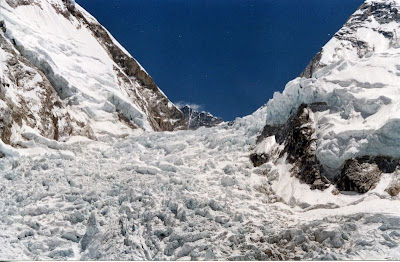 Crevasses form as a means of relieving tensile stress in the more brittle upper layers of the glacier. As a result, they tend to form in areas where the ice is accelerating such as at the top of an icefall or at the crest of a steep slope. They may also form due to some inconsistency in the underlying topography such as a bump or a dome in the bedrock. Brittle surface ice is not as plastic as that found in the deeper layers of the glacier and crevasses will form as a means of relieving the stress created by the bending of the ice as it flows around an obstacle.
Crevasses form as a means of relieving tensile stress in the more brittle upper layers of the glacier. As a result, they tend to form in areas where the ice is accelerating such as at the top of an icefall or at the crest of a steep slope. They may also form due to some inconsistency in the underlying topography such as a bump or a dome in the bedrock. Brittle surface ice is not as plastic as that found in the deeper layers of the glacier and crevasses will form as a means of relieving the stress created by the bending of the ice as it flows around an obstacle.Seracs are the ice towers often seen on glaciers. They form as the ice flows over a dome. Multiple stresses appear creating intersecting crevasse patterns. The resulting towers may be unstable and can be difficult to climb through.
An icefall appears when the gradient of the underlying rock is steep enough that the ice on top accelerates rapidly. Seracs and crevasse walls become tremendously unstable, falling catastrophically down the icefall. Some might be familiar with the Khumbu Icefall on Mount Everest where many climbers have died over the years. That particular icefall moves at almost three to four feet a day causing constant unexpected and catastrophic serac collapses.
When the gradient of a glacier decreases, the ice decelerates. As it does, crevasses close leaving a more level and crevasse free area. Compression zones make for excellent places to camp.
Every climber should have a good understanding of these different characteristics. A complete knowledge of glacial features provides climbers with the ability to choose an appropriate and safe route up a mountain. And this may be one of the most important skills that a climber needs to develop.
--Jason D. Martin
